


歡迎來到全新 Wacom 素描課。今天,我們要學的是如何繪製女性的臉。我們都知道,這個主題賞心悅目,也是我自己的愛好之一。當然,每張臉看起來都略有不同,這取決於人的血統起源、年齡、露出幾隻耳朵等,更不用說每位藝術家的風格差異了。有時即使是同一張臉,早上和晚上看起來也完全不同。
在本逐步指南中,我們將會學到多年來世界各地創作肖像畫、卡通人物畫、漫畫和動漫的藝術家們,在繪製寫實面容時所遵循的一些基本原則。當然,這些並非強制性規則,每位藝術家都能就其自身風格加以調整並重新詮釋。繪製女性面容是一項挑戰性十足的任務,勤加練習並牢記這篇指南絕對會有極大助益。
在本課程中,我們將依自己的想像繪製一張女性面孔,並學習一些必要的訣竅和技巧,讓畫看起來栩栩如生。我們將從建立頭形開始,然後加上特徵,最後再對臉進行微調和上色。希望本課程對你有所啟發,也希望這套方法能在今後的繪畫創作中為你所用。
本課程主要為初學者所設計,但老練的藝術家也可能得到新啟發。我也會談到在電腦上使用繪圖板的工作流程以及數位裝置的優勢。不過,你也可以用紙筆來跟課。
希望你畫得愉快,成果斐然。
目錄

首先要畫一張簡單的構造草圖。只要畫出一些基本形狀,就能輕鬆確定頭、眼、鼻、嘴的位置。
我們先從畫圓開始。畫圓其實並不簡單。如果你沒有一次成功、畫的圓看起來像是立體派畫家的馬鈴薯,可以試著保持手腕固定不動,透過前臂的旋轉畫出圓圈。你也可以像我一樣,嘗試用幾道快速的筆觸勾畫出圓形。如果你的構造草圖看起來不太美觀,也不用擔心。它並不會出現在最終作品裡。

現在,我們穿過圓心畫一條直線。我稱之為「中軸」,因為臉部左右兩側應當大致對稱。

是時候畫一些引導線了:用一條水平線將圓切開。按照這個半圓的高度向下延長中軸。
在圓圈內部,我們再畫兩條短線,把每一半切成兩半。這樣我們就把圓分成了 4 份,又在底部增加了半圓的高度。

現在我們需要一個小一點的圓。別擔心,我們幾乎要完成構造了。這個小圓的範圍是從第三條分割線到最底部。也就是說,它的尺寸是大圓的四分之三。我們還要標出小圓的圓心。

構造完成。是時候來畫剩餘的部分了。將兩個圓連接成一個單獨的形狀。連起來的圓將構成頭骨和下顎。由於沒有突出的骨骼,這應該很容易完成。
你可以把連接線畫成直的,也可以向外彎,取決於你預想中臉部的圓潤程度。如果想畫出憔悴的效果,也可以讓臉頰向內凹陷。

看看我們大膽畫出來的結構多棒呀。因為現在我們確實知道所有部位的位置:
• 頂部四分之一處是髮際線。
• 圓的中心線 — 好吧,也許我們可以省略這個。但有經驗的藝術家都知道:要想取四分之一,就得先取一半
• 下一條線是眼睛位置。是的,眼睛位置確實就那麼低。它們位於臉部在縱向上的中間位置。
• 鼻子最下端正好壓在我們第一個圓的下緣。
• 而嘴巴就位於小圓的中心處。
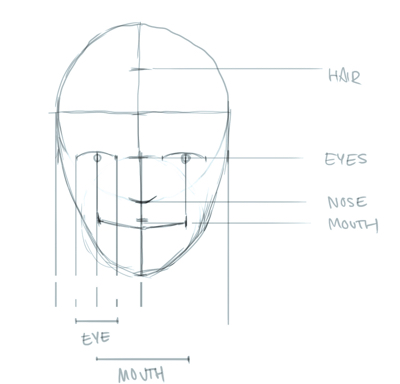
為了不把眼和嘴畫得太寬或太窄,我們要再把臉細分一次,這次是橫向細分。把每一側切成兩半,然後再次切成兩半。這就總共分出了八個等寬部分。
左眼從第二條分割線延伸到第四條分割線,右眼在另一側與之對應。瞳孔位於眼睛正中的第三條分割線處,正好在半張臉的中央。
嘴的寬度與瞳孔之間的距離差不多。勾畫出一雙眼和一張嘴,再畫一個小的 U 形做為鼻子。不用畫得很完美,但一定要明確確定角點的位置。

現在,我們已經確定了眼、口、鼻的位置,可以去掉一些引導線了。但得保留髮際線的引導線,我們最後還會用到它。現在我們第一次完整看到了臉的樣子,此時可以調整一下頭型。女性的頭型比男性的更柔和,稜角較少。因此,得用較為柔和的曲線來繪製頭型輪廓。
我們先從下巴的 U 型曲線開始。儘量對稱地畫出下巴。下巴越窄,臉型就越有女人味。但如果下巴過窄,可能就會意外畫出個外星人。
對下巴形狀滿意後,從額頭頂部開始畫一條新線。首先,順著我們草圖中的圓圈畫線。在眼睛的高度,我們的頭型會不太明顯地微微向內凹。畫到這裡的時候,優雅地繞過臉頰,朝著下巴畫出一條幾乎筆直的線,讓線條在下巴處交會。
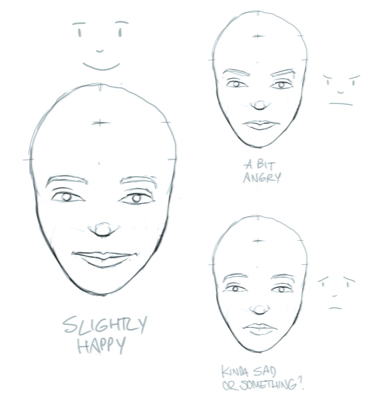
現在該決定讓這位女士在臉上表現什麼心情了。這主要取決於眉毛和嘴尖是朝上還是朝下。我決定畫一張滿足、愉悅的臉。嘴尖微微上翹,眉毛相對居中。

我們的初步草圖已經完成。我標出了眉毛區域,也稍微勾畫了嘴唇。不用擔心,我們馬上就能鉅細靡遺學到所有細節。
在下一章裡,我們將對臉部進行細節處理。

將你的初步草圖當成一個單獨圖層,置於背景中並稍加淡化,使它既能作為描線參考,又不會分散太多注意力。
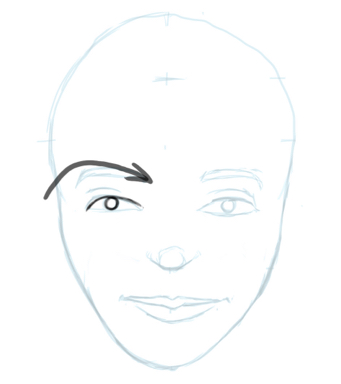
上眼瞼的形狀因人而異。即使是很微小的差異,對臉部外觀也有重大影響。上眼瞼(尤其是女性眼瞼)大體是一條相對陡峭上升,然後平緩下降的曲線。從外側開始畫這條曲線最簡單。

下眼瞼的弧度比上眼瞼稍平。它並非直接從上眼瞼的端點開始。上眼瞼向外側延伸得更多些。此外,下眼瞼外側和內側都可能會微微向上彎曲。外側弧度在人發笑時尤其明顯,因為笑肌會把眼睛外緣往上推。
如果很重視這個面部特徵,這條線可以多畫幾次。
畫瞳孔時,使其靠向上眼瞼。這樣可以產生眼睛直視我們的效果。

上瞼皺褶是面部最浪漫的皺褶。在特定位置觸及上眼瞼的眼瞼皺紋會產生不同的效果。比如,誇張、高聳的眼瞼褶皺可以產生熟知的性感媚眼效果。建議反覆嘗試各種上眼瞼褶皺,因為它可以表達出各種完全不同的情緒。
當眼睛處於放鬆狀態時,標準的眼瞼褶皺幾乎與上眼瞼平行。不過,由於自然狀態下極少存在完全平行的東西,可以讓眼瞼褶皺在線條中段稍微離開眼瞼,再向臉的中間靠近。
在幾何學意義上,虹膜是與瞳孔同心的圓。它的寬度約為整個眼睛的一半。當然,我們並不會畫出完整的圓,因為虹膜的上下兩端都被眼瞼遮住了。可以先為虹膜畫出完整的圓,之後再去掉被遮蓋的部分,這樣可能更容易。
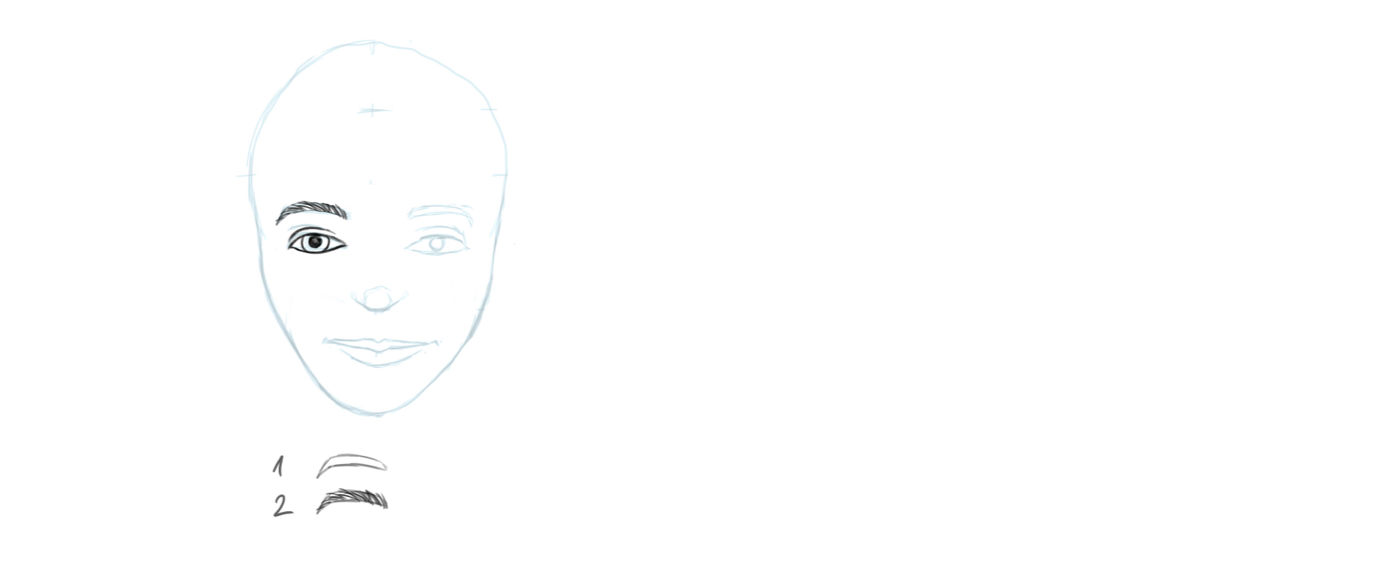
畫眉毛時,先畫出一個區域,之後再填上毛髮。這個區域要稍稍朝外。女性的眉毛往往比男性的窄一些,而且眉弓較為陡峭。但要小心,不要畫得太誇張。
內側眉毛呈 45 度角,並朝外側逐漸變平。最好用大量、快速的筆觸繪製毛髮。從內側開始向外繪製,逐漸小幅度偏轉每根毛發的角度。
在數位時代,使用數位板讓你能輕鬆擦去突出太多的毛髮。

你也可以在數位板上複製甚至鏡映特定區域。然而,眼睛和臉出現的時間可比數位時代早得多。而且,不可能存在兩隻一模一樣的眼睛。最重要的是:你需要練習!

眼睛(尤其是虹膜)具有複雜的結構,由許多精細的形狀和顏色組成。我們可以藉由從瞳孔向虹膜邊緣畫出許多快速交替的黑白細線來實現這種觀感。之後還可以給虹膜塗上顏色。

最後是利用反光來點亮眼睛。反光可以是一個簡單的白點,也可以是幾個點,或者是一扇窗,甚至可以是一整幅風景。我們在此繪製一個不過多遮擋眼部的簡單形狀,達到令人滿意的效果。不要照亮整個眼睛。少即是多。

嘴部線條並不是柔和連貫的。嘴角(即線條外緣)應稍微用力,或用小嘴角皺褶來界定。女性嘴部的一個典型特徵是嘴部褶皺中央的小弧度。
我把嘴畫得比初步草圖中的略窄一些,因為我覺得這樣看起來更為協調。
記得時常全方位觀察你的畫,確認各個部分的位置是否合適。也許你想做些改動?有沒有可以改進的地方?

男性和女性的臉部在嘴唇的厚度和弧度上也有差異。我們從上唇開始:快速畫出兩道微微上升的筆觸,要畫得儘量對稱。
從嘴角畫向中間。第二步,讓這兩道筆觸轉為兩個曲線陡峭的 V 字形。

下唇可以比上唇稍厚,但並非必須。這條線在中間處可稍稍變平。
畫好的嘴有可能會看起來像貼在臉上的貼紙。要避免這種情況,只需運用一個小小的繪畫技巧即可。在下唇線與上唇角之間留出空隙,輕柔提筆結束線條,使其末端指向嘴角。

我們知道,鼻子是臉上向外突出最多的部分。這在側面圖上可能比較好畫,但在正面圖上卻稍顯麻煩。由於只有兩個維度可供支配,我們需要使用一種稱為「透視縮短」的技巧。這可能稍有挑戰性,對初學者來說尤其如此,但只要遵循一個簡單原則就沒問題了:把鼻尖畫成略微向上翹起的短小橫線。在鼻尖兩側接上稍稍向外彎曲的筆觸。

鼻孔起始處非常接近鼻尖的外側。鼻孔下端幾乎是水平的,上端大致指向對側內眼角的方向。
現在,我們來檢查一下臉部整體效果。鼻子有沒有偏大或偏小?會不會太寬了?或者是太窄了?可以將鼻子修改到滿意為止。大多數繪圖程式都有變形工具,也可以用於輔助修改。
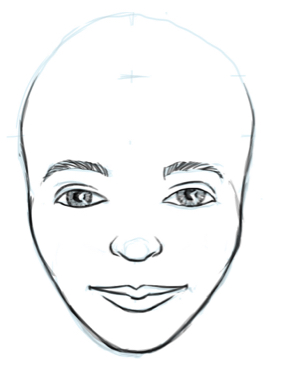
現在我們已經把臉上的重要部位都畫好了,建議最後再調整一下頭型。原則上,我們可以用差不多一樣的方法將初步草圖中的頭型轉移到最終作品中。你也可能會發現有些地方需要稍加改動。

在多款臉部陰影和皺紋樣式中,我選擇了兩種自己愛用的,用在女性臉上效果尤其好。
一是下嘴唇下方的下巴褶皺。它可以定義出下巴,並在視覺上拓寬嘴部區域。
二是臉頰陰影(左側)。這是女人臉部的典型特徵之一。一般要經過多次嘗試才能把臉頰陰影畫在該畫的位置,讓臉既不會顯得太骨感,也不會顯得齜牙裂嘴。

這一步的目的是定位。耳朵的範圍從眼睛延伸到鼻尖。從正面觀察臉部時,耳朵並不呈現出圓形,而是幾乎平貼著頭部。畫出兩個略呈 V 形的小框。

女性臉部有一個重要優勢:就是通常會有很多頭髮遮住耳朵,所以我們可能連畫都不用畫耳朵。耳朵是個相當複雜的結構,有許多角度、褶皺和陰影,可能應該專門為此另開一門課程詳細講述。
因此,我在圖中教大家如何只用簡單的三步繪製出稍顯抽象的耳朵。用兩個框來幫我們實現這一點。
在下一章中,我們將為臉加上頭髮和最後潤飾,包括上色。

希望你還沒有擦掉髮際線引導線。如果擦掉了也不用擔心,我們可以經由觀察臉的其他部分來確定頭髮的位置。
頭髮和耳朵一樣,本身就是一門科學,基本上也需要專門的教學。我儘量把講解精簡成幾句話。
我們先粗略勾畫出髮型的頂點和外緣。最好把這個部分畫在單獨的圖層上,便於之後把初步畫好的頭髮隱藏起來。分發線始於髮際線輔助線位置(本例中畫在中間偏右一點),將筆觸向上掃,儘量畫得優雅。頭髮從頂點開始向兩邊耳朵方向垂下。根據髮型的蓬鬆程度,也可以用幾根並排的線條將髮型確定下來。

頭髮在耳朵以下重新出現,以幾道輕快的筆觸畫出自由下垂的效果。此時,我們也可以順便畫出脖子。
在畫髮際線的時候,你可能會想要添加一些曲線、捲曲或髮型區域。暫時先不要畫出太多細節。
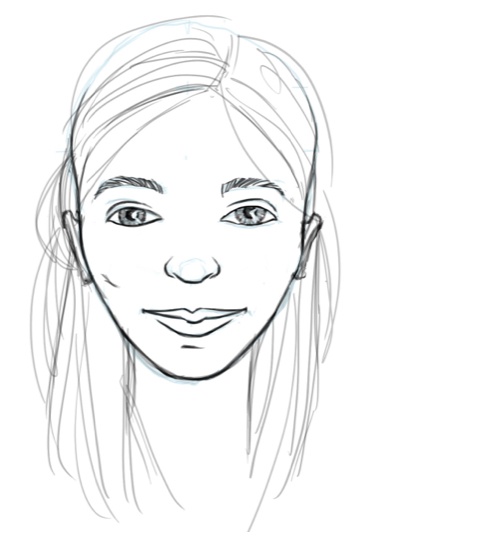
在這一步中,不要緩慢謹慎地勾畫線條,而是要以清爽輕快的方式繪製頭髮。當然,我們並不是要把每一根頭髮都畫出來,而是要研究頭髮在不同處的下垂方向。之後,我們可以用幾道清晰的筆觸將其確定下來。頭髮成簇生長,同一簇頭髮都以相似的方向生長和下垂(而不會縱橫交錯)。我在圖中很隨意地畫出了幾簇頭髮和髮型區域。盡情發揮你的想像力吧。畫頭髮總是很有趣。

等你的手習慣了快速的動作、線條和頭髮的筆觸弧度,就更容易定下清晰流暢的髮型。為頭髮定稿的時候,建議再用一個單獨的圖層。可以在這個圖層中參考之前畫好的髮型繪製定稿,然後如前所述將其隱藏起來即可。必要時,我們還可以擦掉過長且突進臉部的毛髮,而不會擦到臉部本身的線條。繪製髮型的時候,可以嘗試不同的線條寬度和覆蓋度。在這幅畫中,我用深色線條強調各個髮束,而髮束內部的分線則要淺得多,不那麼突出。繪製頭髮時,最重要的依然是畫線的速度。幸運的是,在數位繪圖中,我們可以還原任何不完美的筆觸,直到合適為止。

當然,可做的細節文飾幾乎無窮無盡。這裡舉幾個可能有意思的例子:
• 在眼中添入另一個光點。
• 用與虹膜相同的手法為嘴唇繪出紋理。
• 在鼻孔底部增加微妙的陰影。

希望你畫得開心,也希望本教學能提供一些對今後繪畫有用的技巧。當然,區區一篇教學不可能完全涵蓋這一創作主題的所有方面。
我們將在未來的課程中深入學習更多細節和變化,例如:如何從不同角度畫臉、不同年齡的臉、頭髮-鼻子-耳朵的細節、臉的著色、身體的其他部分、手-腳-身體,以及男性的面容等主題。
本教學目的在於幫助希望提升自我的藝術家打下堅實的基礎。如同任何藝術形式,唯有經常練習才能熟能生巧。如果你對剛開始畫出的作品不滿意,不要沮喪。你一定會越畫越好的。敬請持續關注我們,獲取靈感,享受樂趣。
Wacom One 是繪出栩栩如生的臉部特徵的理想選擇。受惠於 13.3 吋螢幕自然的表面摩擦和極低的反光,Wacom One 能創造出與眾不同的紙上筆感體驗。數位筆手感輕盈自然,其可在你選擇的軟體中化身為鉛筆、筆刷或粉筆,甚至還可以作為橡皮擦使用。精心描繪細節,塑造栩栩如生面孔的最佳選擇。裝置隨附創作用軟體,並可將其連接至你的 Mac 或 PC 以及特定 Android 裝置。
推薦產品

Wacom One 13 手寫液晶顯示器
以精準的數位筆在高解析度螢幕上進行直覺式繪圖、設計和創作。
透過自然的介面技術讓人與科技緊密相依,是 Wacom 一貫的願景。這項願景讓 Wacom 成長為全球的互動式數位板、手寫液晶顯示器及數位筆的龍頭製造商,更是數位簽章保存與處理解決方案供應商。Wacom 直覺式輸入裝置的先進技術,已在全球各地造就出許多一流數位藝術、電影、特效、時尚及設計鉅作,其領先的介面技術同時為商業和家庭用戶提供表達自我個性的利器。創立於 1983 年的 Wacom 是全球性企業,總部位於日本(東京證券交易所股號:6727),分公司及行銷與銷售代表處遍佈世界各地 150 多個國家。